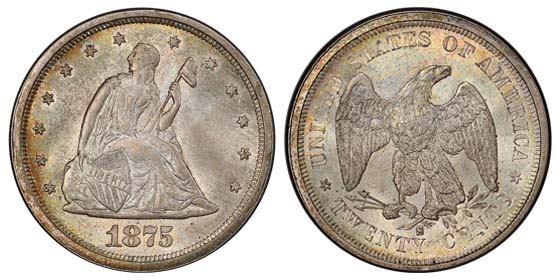Twenty Cent Coin Values
How Much 20 Cent Coins are Worth: 20 Cent Coin & Coin Price Chart

Year | Mint | Variety | Designation | VG-8 | F-12 | VF-20 | EF-40 | AU-50 | U-60 | MS-63 | MS-64 | MS-65 | MS-66 | MS-67 |
|---|---|---|---|---|---|---|---|---|---|---|---|---|---|---|
1800 | P | Plain 4- Stemless Wreath | Red-brown | 200 | 300 | 400 | 500 | 600 | 700 | 800 | 900 | 1000 | 1200 | 1100 |
| Year | Mint | Variety | Designation | VG-8 | F-12 | VF-20 | EF-40 | AU-50 | MS-60 | MS-63 | MS-64 | MS-65 | MS-66 |
|---|---|---|---|---|---|---|---|---|---|---|---|---|---|
| 1875 | (None) Phil | -- | -- | $235 | $274 | $320 | $450 | $612 | $1,025.00 | $1,695.00 | $2,435.00 | $5,200.00 | $21,300.00 |
| 1875 | CC | -- | -- | $330 | $437 | $500 | $910 | $1,184.00 | $2,310.00 | $3,845.00 | $6,575.00 | $18,600.00 | $53,000.00 |
| 1875 | S | -- | -- | $175 | $240 | $222 | $281 | $390 | $872 | $1,225.00 | $1,895.00 | $3,140.00 | $5,065.00 |
| 1876 | (None) Phila | -- | -- | $367 | $455 | $544 | $675 | $844 | $1,448.00 | $2,615.00 | $3,135.00 | $4,190.00 | $16,050.00 |
| 1876 | CC | -- | -- | -- | -- | -- | $154,000.00 | $181,500.00 | $305,750.00 | $426,000.00 | $582,250.00 | $817,000.00 | $1,165,000.00 |
History of the Twenty Cent Piece
The Twenty Cent Piece, also known as the 20 Cent Coin, was minted from 1875 to 1878 and is one of the shortest-lived denominations in history. In the West, there was a shortage of small-denomination coins, partly because base-metal coins like nickels were not widely accepted, and the half dime had been abolished. The Twenty Cent Piece was intended to facilitate small transactions to combat the supplanting of foreign silver in Western commerce and to ease political pressure from Western mining interests.
Designed by William Barber, the obverse features a left-facing depiction of Liberty seated on a rock, holding a shield and a Liberty cap. The reverse showcases an eagle with outstretched wings, clutching arrows and an olive branch.
The coin’s design closely resembled the Seated Liberty Quarter, causing confusion among the public due to its similar size and appearance. This confusion and limited practical need led to the coin’s early discontinuation.
Rarest Coins in the Series
- 1875-1876 Business Strikes: Regular production coins were minted in Philadelphia, Carson City, and San Francisco, with Carson City issues being the most desirable.
- 1875-1876 Carson City Issues: Known for their historical connection to the Western United States and their rarity.
- 1875-CC: Has a relatively low mintage of 133,290 coins, making it the most sought-after business strike.
- 1876-CC: 10,000 coins were struck, but nearly the entire mintage was melted, leaving about 20 coins still in existence, making it one of the greatest conditional rarities in U.S. coinage.
- 1877 Philadelphia Proof: With 510 proof coins minted, these coins are popular among advanced collectors.
- 1878 Philadelphia Proof: Similar to the 1877 issue, with very limited mintage limited mintage of 600 proofs.
After 1878, the series was officially discontinued, and most remaining coins were melted down, adding to their scarcity today.
Types of Collections
- Basic Date and Mintmark Set: Collect one example of the 20 cent piece from each year of minting (1875-1878) including all mintmarks: Philadelphia (no mintmark), Carson City (CC), and San Francisco (S). This forms a foundational set for the short-lived series.
- Type Set / Design Variations: Focus on acquiring coins with design or variety distinctions, such as the 1875-S/S repunched mintmark and overdate varieties, known die clashes, and proof design nuances to create a varied and visually interesting type collection.
- Proof and Specimen Collection: Collect the proof-only 1877 and 1878 issues, which are extremely rare with only 350 proofs struck each year, highly prized by advanced collectors looking for prestige and investment worthiness.
- Mint Specific Collections: Collect exclusively Carson City (CC) issues from 1875 and 1876, noted for their rarity and desirability. Alternatively, focus on San Francisco (S) or Philadelphia pieces, organizing by mint location for a specialized theme.
- Investment and Key Rarity Set: Concentrate on the rarest and most valuable pieces in the series such as the 1876-CC, proof coins, and low-mintage mint marks, aiming for high-grade certified coins that appreciate over time in value.
Beginner vs. Advanced Collecting
Beginner Collecting
Twenty Cent Pieces are scarce; new collectors may need to search patiently at coin shows, auctions, or specialized dealers. Focus on key visual markers: clear Liberty details, distinct eagle feathers, and minimal surface marks. Store coins in airtight holders to preserve condition.
Advanced Collecting
Because mintages are limited and prices often high, this series is typically pursued by seasoned collectors. High-grade business strikes, Proofs, and major rarities, such as the 1876-CC (largely melted) and the Proof-only 1877 and 1878 issues, can be challenging to locate and costly to acquire.
Investment Potential
The Twenty Cent Piece remains a strong investment option, particularly for low-mintage issues, proof-only years, and high-grade certified examples. The 20 Cent Piece value continues to appreciate due to their historical significance and collector demand.
